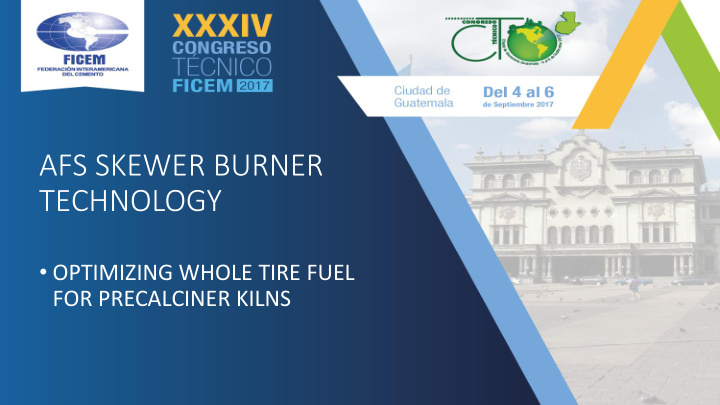



AFS SKEWER BURNER TECHNOLOGY • OPTIMIZING WHOLE TIRE FUEL FOR PRECALCINER KILNS
AFS SKEWER BURNER TECHNOLOGY • Prepared by: John Tiernan • Presented by: Raul Montes de Oca
INTRODUCTION Challenges of using whole tire fuel in precalciner kilns • Sulfur Cycle • Localized Reduction History of Suspension Burning The Latest in Suspension Burning Technology Maximum Performance Potential
Precalciner Kil iln - Tire Fuel P Performance Precalciner kilns are typically limited in the amount of whole-tire fuel they can burn. • Traditionally tires are fed in to the low oxygen environment of the kiln backend • Localized Reducing Conditions • Excessive sulfur buildup • 5% to 10% substitution rates
Double Gate Airlock Valve DOUBLE GATE AIRLOCK VALVE TIRE CHUTE KILN BACK END FEED SHELF
Cause for Limited Feed Shelf Firing Extended Sulfur Cycle In Precalciner Kilns DOUBLE GATE AIRLOCK VALVE Riser Duct Localized Reducing COAL BURNERS 2% Excess Oxygen High Temps of 1050° C
Whole Tire Suspension Burning SUSPENSION BURNERS COAL BURNERS
Rack-Style Suspension Burner System La Calera, Chile • 1 tph per burner • No sulfur buildup issues from tires
The La Calera, Chile Rack-Style Suspension Burner System
The La Calera, Chile Rack-Style Suspension Burner System 3 Phase Project starting in 2001 • Testing Burner • Automated Burner with Hook Elevator • Second Burner in 2007
The La Calera, Chile Rack-Style Suspension Burner System • Allows for 2 car tires or 1 truck tire • Wire buildup on forks was an ongoing Rack Style Suspension Burners provide 0.7 to 1 ton per hour of whole tyre fuel
The problem that inspired the idea of skewer
The Skewer Originally designed to suspend a shish kabob… and now your tires
THE SKEWER BURNER since 2013
Rod Length = Feed Rate Feed rate rule of thumb 2.0 m = 2.0 tph 1 tph / 1 meter of skewer rod
Rod Length = Feed Rate Feed rate rule of thumb 4 m = 4 tph 1 tph / 1 meter of skewer rod
The First Skewer Suspension Burner For TXI Midlothian Skewer Suspension Burner prototype
New Spanning Skewer with Wire Removal for San Gabriel DOUBLE GATE AIRLOCK VALVE WEIGHT AND DIAMETER MEASUREMENTS HOT RAM LOADING CHAMBER SKEWER ROD WIRE RECOVERY
New Spanning Skewer with Wire Removal • Enclosed loading chamber • No hydraulics • Electric servo motors • Air cylinders for airlock valve
Skewer Rod Life • Shown is skewer rod after 12 months use in calciner. • Rated for 1,200°C. • First rod was used for a total of 36 months
Cantilevered Skewer vs. Spanning Skewer CALCINER OD Spanning Skewer Cantilevered Skewer
Truck Tire Performance • 4 truck tires per meter of skewer • 5 car tires per meter of skewer • Truck tires are 4.5 x heavier • 180 kgs vs 50 kgs / meter • 3.6 time more fuel / meter • Less problematic in conveyors • Overall excellent fuel for skewer
FUEL COST SAVINGS EXAMPLE COMPLETE SKEWER SYSTEM INCLUDING: SEMI-AUTOMATIC HANDLING SYSTEM WITH INSTALLATION • 3 tons/hour x 330 days of system operation = 23,760 metric tons of tire fuel annually • Approximate tyre heat value 1.2 times coal = Replacement of 28,512 tons of coal annually • Coal cost savings of $100/ton = $2.85 million/year fuel cost savings • Approximate turnkey system cost $2.0 million USD Approximately 9 month return on investment
AFS Fully Automatic Tire Feeding Systems
La Calera Chile System Hook Elevator System MAINTENANCE PLATFORM HOOK ELEVATOR CENTERING CONVEYOR MANUAL LOADING BELT
San Gabriel Skewer Burner System 4.0 t/h SKEWER LOADING Rated SYSTEM capacity 5m SKEWER ROD FOR COMBUSTION CONVEYOR 5.7 m O.D. SYSTEM FROM CALCINER GROUND LEVEL
SUMMARY Precalciner kilns are whole-tire fuel limited when tires are fed to the kiln backend, which causes localized reducing conditions leading to excessive sulfur buildup in the riser duct and upper vessels. The Skewer Suspension Burner enables cement kilns to retain high amounts of whole-tire fuel in the optimal burning position of the oxygen rich calciner. As a result, precalciner kilns can burn higher amounts of whole-tire fuel without creating additional CO or SO2 from tire combustion.
Muchas gracias por su atencion
www.afstechnology.com
Preguntas?
Localized Reduction • Reduction involves a decrease in oxygen and in this case it is a decrease in the raw material oxygen • The gas stream is being reduced by the volatiles in the fuel • When the volatiles deplete the gas stream of its oxygen, this leaves no oxygen for the slower burning fixed fuel carbon • The fixed fuel carbon needs its oxygen for combustion from somewhere and finds it in the raw material sulfur This is localized reduction
Recommend
More recommend